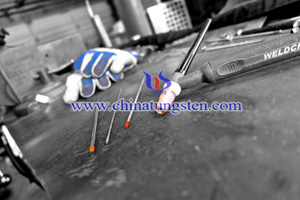Tungsten Electrode Used in Gas Tungsten Arc Welding (GTAW)
- Details
- Category: Tungsten Information
- Published on Thursday, 21 April 2016 18:15

Gas tungsten arc welding (GTAW) is an electric arc welding process that produces an arc between a nonconsumable tungsten electrode and the products to be welded. Besides, the weld is shielded from the shielding. GTAW has widely used range. On one hand, it can be used on ferrous and nonferrous metals welding, depending on the base metal, in all welding positions. On the other hand, it also can be used to weld thin or thick materials with or without a filler metal.
Using GTAW for thin or thick material welding is not the same. When welding thinner materials, edge joints, and flange, filler metals are not used. For thicker materials, an externally fed filler wire is generally used. The type of filler metal wire to be used is based on the chemical analysis of the base metal. The size of the filler metal wire depends on the thickness of the base metal, which usually dictates the welding current. Besides, the methods of operation for GTAW can be manual or automatic.
Tungsten electrode is an important part in GTAW welding. Tungsten has high temperature property, so it can be used in high temperature environment for long time without deformation. There are many tungsten electrode types including pure tungsten electrode, thoriated tungsten electrode and certiated tungsten electrode and so on. Besides, it also has different size, and the size of an electrode to be used is determined by the welding current required. Larger electrodes permit higher currents to be used. Smaller diameter electrodes may be used for welding thinner materials or while welding out of position.
Pure tungsten electrode used on nonferrous metals, such as aluminum and magnesium, and is typically used with a balled-end preparation on AC.
Thoriated tungsten electrode is the most widely used type and it usually use on carbon and stainless steel. It can be purchased with 1 or 2 percent thorium. The thoriated tungsten starts readily and maintains a stable arc. It has a greater resistance to contamination and will maintain a sharp point and will not break down as readily as pure tungsten.
Zirconiated tungsten electrode is welding with higher AC currents on nonferrous metals.
| Tungsten Metals Supplier: Chinatungsten Online www.tungsten.com.cn | Tel.: 86 592 5129696; Fax: 86 592 5129797;Email:sales@chinatungsten.com |
| Tungsten News & Prices, 3G Version: http://3g.chinatungsten.com | Molybdenum News & Molybdenum Price: http://news.molybdenum.com.cn |